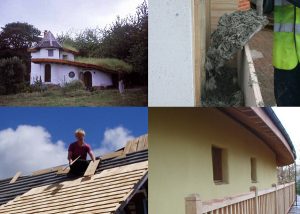By natural house we mean one that uses natural materials that don’t damage the environment in their manufacture or use, and that is good for the health of its inhabitants. These qualities typified houses built before the introduction of cement and other impermeable / inflexible building materials. Typical differences between traditional / natural buildings and modern ones are laid out below.
| traditional / natural house | modern house |
| breathable materials | airtight |
| flexible | inflexible |
| repairable | low-maintenance |
| recylcable | non-recyclable |
| low-energy materials | high-energy materials |
| local materials | materials not local |
| natural materials – eg straw, earth, lime, timber, stone, slate | manufactured materials: cement, plastics |
- There’s a debate amongst environmentalists around energy efficiency versus natural, local materials in buildings, and at the moment, energy efficiency is seen as the priority. Modern houses are sealed for energy efficiency, and this is seen as a great contribution to environmental protection, which in a way it is. But it necessitates the production and distribution of environmentally-damaging materials, using lots of energy (with the consequent pollution) to produce. It also blocks the recycling of old doors and windows etc.
- Also, hermetically-sealed houses restrict ventilation, and allow dust, dead skin particles and house mites to build up, causing increases in asthma.
- The impervious materials don’t allow any moisture that enters the structure when cracks appear to escape again, which can cause damage to the building.
- We have moved away from houses with a) a wood stove or fire, b) wooden sash windows, c) heavy curtains to stop draughts and d) natural, breathable materials.
- We have moved to houses with a) central heating, b) plastic double glazed windows and c) manufactured, impervious materials.
- This situation has come about largely for economic reasons, but without any benefit for the health of people, buildings or the environment, and in most cases to their detriment. Unfortunately, economics seems to take precedence over all other considerations in most areas of life these days.
- The materials used in a traditional house are more environmentally-friendly in their manufacture, extraction, distribution (if local), carbon neutrality, and recyclability / biodegradability. Lime allows other natural materials to be used, but cement and other impervious materials are incompatible with natural ones.
- Natural houses can often be self-built very cheaply compared with conventional modern homes, but involve a different way of thinking – small-scale, unique rather than uniform, in harmony with nature.
- Domestic dwellings don’t need much strength; what they do need is to be flexible, breathable, and non-toxic so as not to poison the inhabitants.
- Lime can also be used with flint for foundations.
- At Redfield, in the mid 1990s, we changed the regime we use to maintain our sash windows (all 195 of them, including the stable block). We moved from weatherproof paints, cement mortars around the windows, mastics, and impermeable fillers (we even found fibreglass car body filler used on sills) to breathable eco-paints based on thistle oil, lime mortar, and linseed oil putty for filling cracks in sills etc. We found that once water got behind impermeable materials, it sat there and rotted the wood. The new regime seems to have solved this problem, and it will reduce the amount of maintenance work we have to put in in future, as natural paints only need a light sanding before adding another coat, instead of stripping waterproof gloss paints off with a hot air gun and scraper.
- We feel that the more processed materials are used in houses, the more they alienate their inhabitants from nature. This is happening in most other areas of people’s lives too, and a population divorced from nature won’t be as concerned with its protection.
- Self-built houses made from natural materials lend themselves well to, and benefit from, lime rendering. Materials tend to be porous, and so adhesion will be good; and they may deteriorate over time if unprotected – e.g. straw, cob, wattle and daub. With harder materials such as rammed earth, timber or stone, a lime slurry (see below) may be preferable, as it will offer very good protection, but will need less lime putty, and be much easier to apply, and yet be very attractive.
- Also, there’s aesthetics. Classic buildings made from natural materials tend to look better as they get older – thatched cottages built 500 years ago are probably the most beautiful buildings we have in the UK, and yet houses and flats built with manufactured materials in the 1960s are possibly the ugliest – and they won’t improve with age either. This may be subjective though, and only true when viewed with Western eyes. A Romanian visiting Buckinghamshire commented on thatched cottages: ‘oh, those poor people, having to live in cottages made from timber and mud, with grass roofs – are they peasants?’.

